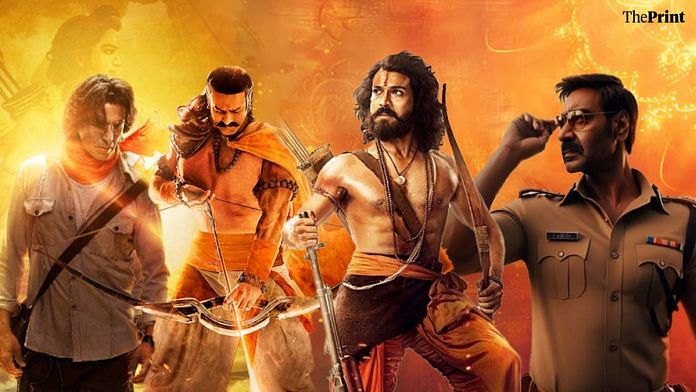Cars blowing up, bullets flying, and tough-talking cops are back in Rohit Shetty’s Singham Again—only this time, the action comes with a heavy dose of the Ramayana. Helicopters swoop in alongside the mythical Garuda, the villain declares himself a Ravana, and Ajay Devgn’s supercop Singham is styled as a modern-day Ram, leading a Lakshman-Hanuman-Jatayu-like crew to save his ‘Sita’.
In the five-minute trailer for this 1 November release, these Ramayana references are anything but subtle. They’re splashed across the dialogues and visuals. The movie also hammers home the point with a Hanuman Chalisa-inspired track, Jai Bajrangbali, featuring Ranveer Singh as Simba, Singham’s loyal sidekick.
This isn’t the Ramayana of Ramanand Sagar’s 1987 TV serial, with its bows, arrows, and philosophical debates. This is the Ramayana of muscle, swagger, and raw power.
Mythology as entertainment isn’t new in India. TV serials from the late ’80s to early 2000s brought gods and epic tales from the Ramayana and Mahabharata into millions of homes. But today, the tone has shifted, especially in Ramayana-inspired movies. Films directly or indirectly based on the epic have been coming up with increasing frequency since 2022, but the heroes are not calm and contemplative anymore—they are battle-hardened warriors, wielding weapons and nationalist pride.
SS Rajamouli’s RRR (2022) set the stage, followed by Abhishek Sharma’s Ram Setu (2022), Om Raut’s Adipurush (2023), and Prasanth Varma’s Hanu-Man (2024). October saw the re-release of Ramayana: The Legend of Prince Rama (1992) and Singham Again has had its Diwali release. And there’s more to come— including the upcoming pan-Indian production Ramayana, starring Ranbir Kapoor and Sai Pallavi, and Jai Hanuman, the sequel to Hanu-Man, starring Rishab Shetty.
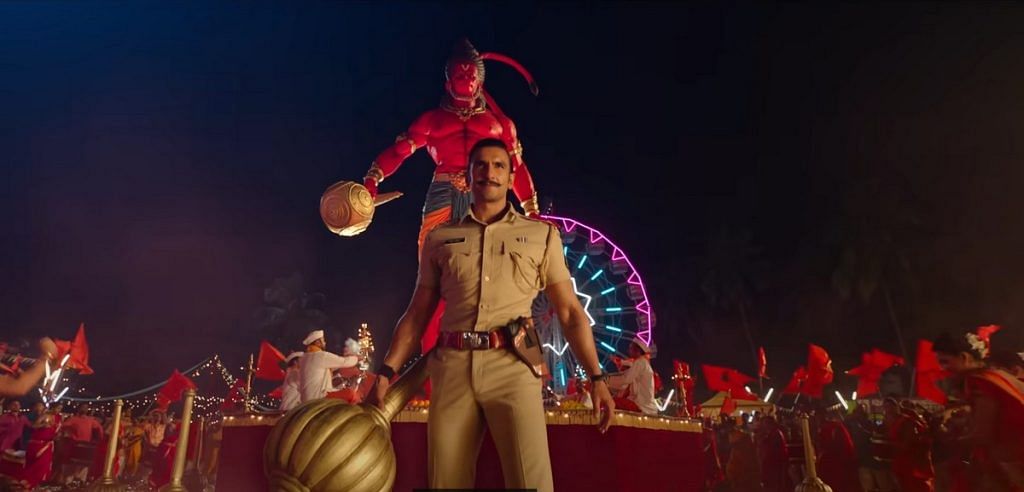
In most of these films, the Ram-inspired character is hyper-masculine, hyper-muscled, and hyper-Hindu. According to film scholar and former JNU professor Ira Bhaskar, this portrayal of Ram aligns with the construction of Ayodhya’s Ram Mandir and the ruling government’s use of the god as a symbol of militant Hindu identity.
“When the Ram Janmabhoomi movement started in the 80s, building up to demolition of the Babri masjid, posters of Ram holding a bow and arrow were found in various places. With the BJP coming to power three times in a row, that image of Ram has become the preferred one, also for its own politics,” Bhaskar said.
It is opportunistic, a way to capitalise on Hindu sentiments. But filmmakers don’t realise that using Hindu myths as a crutch has diminishing returns
-Kaveree Bamzai, journalist & author
But not every Ramayana-inspired film has struck gold. While RRR, simultaneously released in Telugu and Hindi, made Rs 1,236 crore worldwide and was declared a top grosser, Adipurush, made on a humongous budget of Rs 500 crore, only managed to earn Rs 400 crore worldwide. Ram Setu, which cost Rs 150 crore to make, earned Rs 92.94 crore.
This has not deterred Rohit Shetty. He’s assembled a massive star cast and pumped Rs 250 crore into Singham Again, his most expensive film yet. It has Singham heading overseas for a “covert operation” to save his wife, played by Kareena Kapoor.
“There has been a tradition in India—when Sita is abducted, Lanka has burned. History is about to repeat itself,” warns a voiceover in the trailer.
Whether this Ramayana-heavy action spectacle pays off remains to be seen, although Singham Again, the third installment of a successful franchise, did reportedly get a “bumper opening day”.
Amish Tripathi, bestselling author of the Shiva trilogy and Ram Chandra series, pointed out that for many, the Ramayana has now become more of a money-making tool than an exploration of its deeper themes.
“The elite had stayed away from the epics, be it the English-speaking population of India or even Bollywood directors,” Tripathi said. They are now re-discovering them on movies and even social media.”
Also Read: Padmaavat to The Kerala Story, how new-age Bollywood films spread Hindu nationalism
Blockbusters and blunders
When it comes to myth-inspired blockbusters, Telugu filmmaker SS Rajamouli is the undisputed king. His two-part Baahubali, released in 2015 and 2017, was inspired by the Mahabharata and became the first record-smashing pan-India hit. Then in 2022, he did it again with RRR—a cocktail of explosive action, Ramayana and Mahabharata references, and freedom-fighter heroics.
Other Telugu pan-Indian mythology-inspired films have had similar success, including Nag Ashwin’s Kalki 2898 AD (2024), a big-budget sci-fi-meets-scriptures blockbuster, and the superhero hit Hanu-Man (2024)—praised for its “careful treatment of the source material” and for prioritising pace and plot over proselytising.
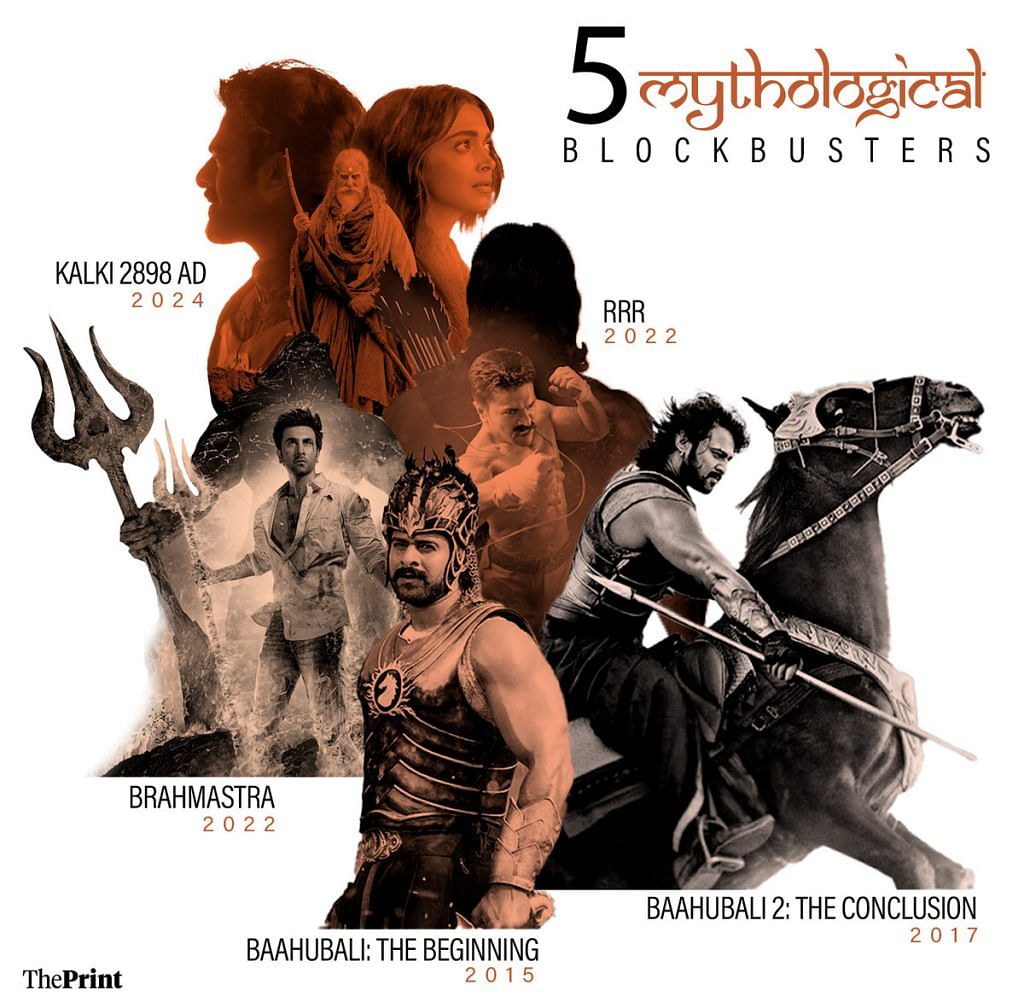
Hindi filmmakers have tried jumping on the epic-action bandwagon in recent years too—but their results haven’t clicked as well with audiences.
For Amish Tripathi, success in this genre is about more than putting up a flashy show—it’s about sensitive storytelling.
“If you make a respectful interpretation, Indians can see the intention. That is why Prabhas lifting a Shivling (in Baahubali) did not create any controversy. Both Rajamouli and his father V Vijayendra Prasad have been respectful in their intent,” said Tripathi.
With its over-the-top action, anti-colonial message, and high-octane storytelling, it’s easy to overlook the unsaid fourth “R” in RRR (Rise Roar Revolt)—Ramayana.
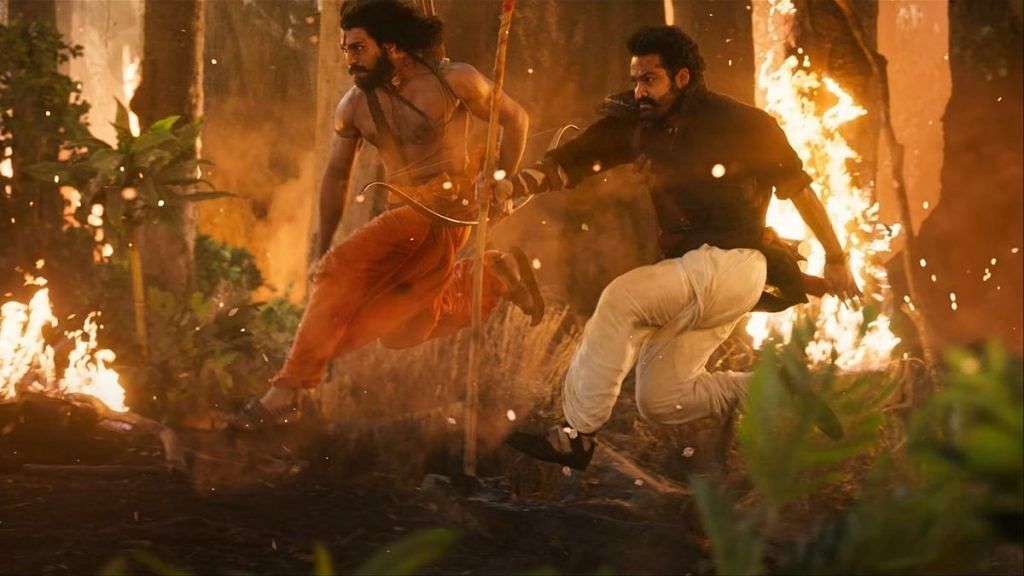
This international mega-hit deftly blends history with mythology, celebrating freedom fighters Rama Raju (Ram Charan) and Komaram Bheem (Junior NTR) while assigning them traits of Ramayana and Mahabharata heroes. In a clever role reversal, when Rama Raju is captured by British officers, it’s Komaram Bheem who, carrying a message from Sita (Alia Bhatt), heroically rescues him. Then, there’s the famous scene where Raju dresses like Lord Ram, bow and arrow in hand.
In contrast, Hindi films Adipurush and Ram Setu both stumbled badly at the box office.
Ram Setu tried to capitalise on the widespread belief that the Ramayana is not just an epic. This it did by going full Indiana Jones through the mission of archaeologist Aryan Kulshreshtha (Akshay Kumar) to “prove” the existence of the Ram Setu bridge built by Lord Ram’s monkey army . This “proof” is duly discovered, atheist Aryan finds his faith, and a character named AP turns out to be Hanuman himself. But critics panned the film as ideologically heavy-handed, audiences were indifferent, and some archaeologists were downright annoyed.

“The ridiculous depiction of archaeology and archaeologists is irritating. Romanticisation is one thing, and exposure would be great, but not in this way,” said Disha Ahluwalia, archaeologist and junior research fellow at the Indian Council of Historical Research. “Archaeology is being exploited to give definite answers about the epics. It cannot give immediate answers—it can take decades.”
Then there’s Adipurush, which aimed to retell the Ramayana with a modern twist but found itself in hot water even before its release. Shoddy VFX and cringeworthy, “tapori” dialogues —like Hanuman saying, “Kapda tere baap ka, tel tere baap ka, aag bhi tere baap ki, aur jalegi bhi tere baap ki” (Cloth is your father’s, oil is your father’s, fire is also your father’s, and it will burn your father as well)—turned the trailer into meme fodder, forcing the creators to re-shoot parts. Things got so bad that legal complaints were filed, and dialogue writer Manoj Muntashir had to issue an apology.

Such portrayals, film scholar Ira Bhaskar argues, are part of a wider trend of “appropriating” the figures of Ram and Hanuman in both politics and film. But these depictions have become more regimented over the years, with a particular kind of Ramayana now prevailing.
It’s more muscular, but less flexible. The epic is no longer reimagined as freely as it once was. Today’s Ramayana-inspired films seem more focused on testing VFX limits than pushing narrative boundaries.
‘You cannot make a Raavan now’
Just as there are countless oral and written versions of the Ramayana, filmmakers have experimented with it in their own ways, some more boldly than others. In the Malayalam film Kanchana Sita (1977), G Aravindan cast tribal actors as Ram and Lakshman and used nature to symbolise Sita, creating a “feminist” retelling.
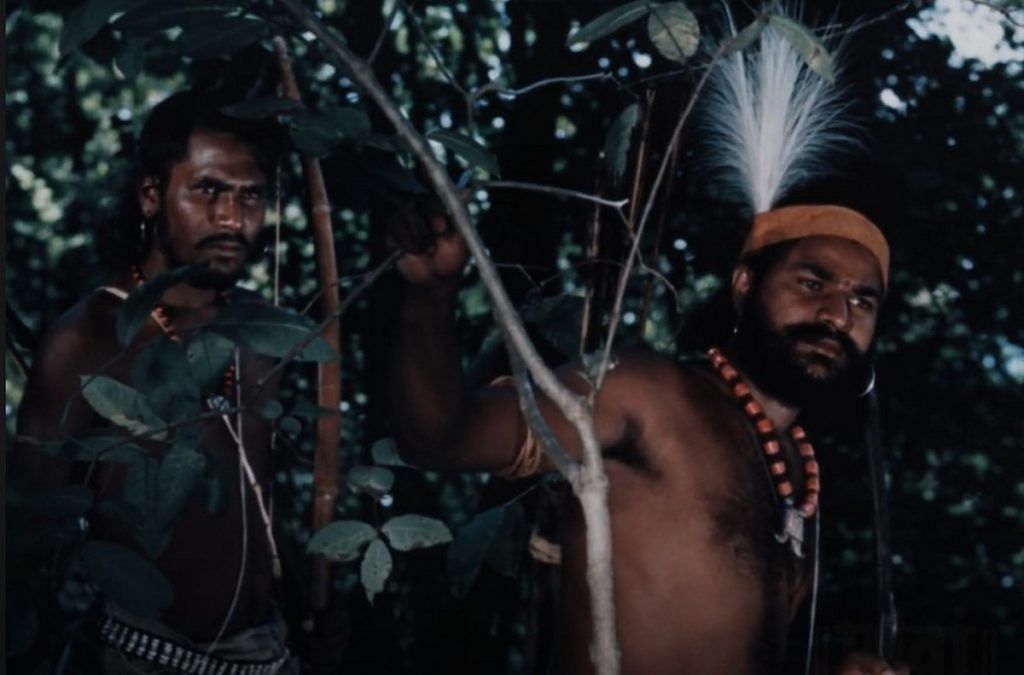
More recently, Mani Ratnam’s Raavan (2010)—made in both Hindi and Tamil—looked at demon-king Ravan through a sympathetic lens rather than valorising Ram.
The plot draws on the Ashokavanam episode, where Ravana abducts Sita and Ram embarks on a rescue journey. But Ratnam uses contemporary politics to grey the question of who the real hero is.
In the Hindi version, Abhishek Bachchan plays Beera Munda, a Ravan-inspired outlaw who runs a Robin Hood-style parallel government in rural Tamil Nadu and is branded as a Naxalite by the police.
Dev (Vikram), a ruthless cop hunting Beera, crosses the line when one of his men assaults Beera’s sister, leading to her death. In retaliation, Beera kidnaps Dev’s wife, Raagini (Aishwarya Rai Bachchan), and as she learns his story, she starts to see her husband through more critical eyes.
If you make a respectful interpretation, Indians can see the intention. That is why Prabhas lifting a Shivling (in Baahubali) did not create any controversy
-Amish Tripathi, author
Ratnam uses this tale to showcase caste oppression and the abuse of state power. Beera becomes a tragic hero, while Dev’s motives come under scrutiny—a twist that would be hard to pull off in today’s climate.
“You cannot make a Raavan now,” said a director who assisted Mani Ratnam in the film. “It would be a suicidal move by producers and makers. It is very clear that the government does not support a certain kind of interpretation of the epic.”
Ratnam’s film was a spotlight on the many Ramayanas of South Asia— and the fact that Ravana is revered as a powerful king in Sri Lanka.
But interpretations that deviate from the dominant political and historical narrative are rarely without risk—even if they draw directly from original texts.
While Ratnam escaped unscathed, a controversy was brewing in academia. In 2011, Delhi University removed scholar AK Ramanujan’s seminal essay, ‘Three Hundred Ramayanas’, from its history syllabus after right-wing groups claimed it ‘hurt religious sentiments’.
Ironically, they were angry about excerpts quoted in the essay—including passages from Valmiki’s Ramayana itself.
Also Read: Firearms, forests & fugitives constant in Bollywood’s Naxal films—politics keep changing
TV to Bollywood
Indian television’s golden age of mythological serials began in the late 1980s, when Ramanand Sagar’s Ramayan and BR Chopra’s Mahabharat turned weekday evenings into sacred viewing hours for millions.
Later, Zuby Kochhar’s Om Namah Shivay (1997-2001), Sanjay Khan’s Jai Hanuman (1997-2000), and BR Chopra’s Ramayan (2001-2002) also found loyal audiences. Devon Ke Dev…Mahadev (2011-14) on Life OK and Mahabharat (2013-14) on Star Plus continued the trend and are now available on Disney+ Hotstar.
But the series with the longest shelf life is the original Ramanand Sagar Ramayan. It was re-telecast on Doordarshan during the 2020 Covid-19 lockdown, where it racked up over 190 million viewers, and then again on Shemaroo TV last year, amid fans comparing Adipurush unfavourably to it.
The latest mythological offering on TV, Shrimad Ramayan (2024), produced by Siddharth Tewary, was also reportedly inspired by the backlash against Adipurush.
In an interview with India Today, Tewary said that he created the show to “let people know about the original story” following the Adipurush controversy.
“I have a proper research team and everything that’s going out, every word about this show is properly vetted,” he claimed.
However, the allure of mythology in TV serials seems to be wearing a little thin. Shrimad Ramayan, with a set costing Rs 100 crore, has struggled to reach even a 2.0 TRP rating.
Meanwhile, Bollywood, which has been slower to embrace mythology on a grand scale, is now seeing its epic potential.
“It is not that there was no audience for mythology before. But in both English language books written by Indian authors, and Hindi cinema, there was a gap. That is why my books were appreciated, and now films are being made in Bollywood,” said Amish Tripathi. In January, he presented a documentary titled Ram Janmabhoomi Temple: The Return of a Splendid Sun, which started streaming on Jio Cinema just three days after the inauguration of the Ram Mandir in Ayodhya. It became one of the most-watched unscripted Hindi shows on OTT.
However, success isn’t guaranteed for Bollywood’s Ramayana movies, said Kaveree Bamzai, senior journalist and author of The Three Khans—what worked for an RRR may not work for a Singham Again.
“It is opportunistic, a way to capitalise on Hindu sentiments,” Bamzai added. “But filmmakers don’t realise that using Hindu myths as a crutch has diminishing returns.”
(Edited by Asavari Singh)



